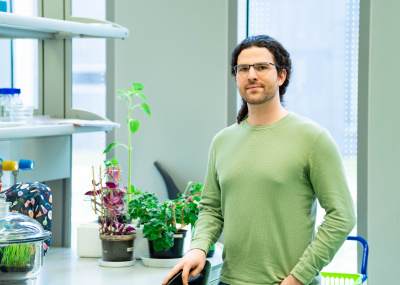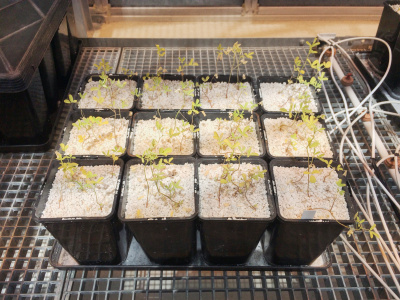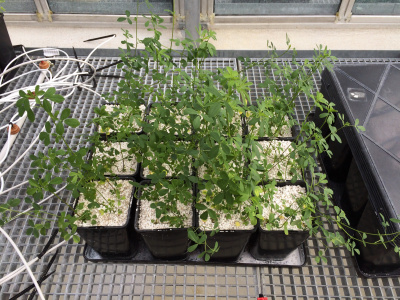When does nature go hand in hand with technology? For one, during the research activities of George DiCenzo from Queen's University in Canada. He visited University of Gdańsk in March thanks to "Visiting Professors" programme. We asked our guest about his collaboration with prof. Ewa Łojkowska’s team and his efforts to enhance the legume-loving rhizobia.

prof. George DiCenzo, fot. Marcel Jakubowski
Marcel Jakubowski: - It's not your first collaboration with Professor Ewa Łojkowska. Right now, you are a consultant on the project conducted by her team, that concerns the antibacterial solutions of plasma. What is your role?
Prof. George DiCenzo: - It’s an interesting project. Their work is based on experiments with the antibacterial solutions of plasma. My background is both in experimental work and in bioinformatic work, and so far I've provided some ideas and feedback on their ideas to help.
- You also wrote an article with dr Agata Motyka-Pomagruk about using fermented grapes in synthesizing gold nanoparticles about five years ago. Was this your first collaboration with a scientist from University of Gdańsk?
- Yes. In 2016 at the University of Florence dr Agata Motyka-Pomagruk and I were both doing internships as PhD students, and that's where we first met. That project involved University of Gdańsk, me and other scientist from Wrocław. It was jointly designed, thanks to various input from all of us. Since it was a project that we have prepared together, we also wrote the paper to describe the results.
- Did you continue your collaboration with dr Agata Motyka-Pomagruk ?
Yes. Our time in Florence overlapped by two months, we worked in the same lab, our desks were side by side, so we got to know each other pretty well. Since then, she has been doing a lot of fascinating science. It was great to keep in touch with her.
- For almost two weeks, you have been teaching University of Gdańsk’s PhD students your own course. What skills do you want them to develop?
This course is on bioinformatics and comparative genomics, which are fields that use computers to analyze biological data. I'd like for PhD Students to learn some basic skills that they can utilize for their own research, e.g. how to use different bioinformatics tools, mainly online tools, and what questions they can answer with these tools. I hope that the course will help them to analyze their own data with special programs and to understand the results. Because it's important to not only know how to use the tools, but also to understand the output.
- During your stay in Poland you are also doing your own research activities with professor Ewa Łojkowska’s team, that concern the visualization of big data, acquired thanks to RNA sequencing experiment. Could you tell us a bit more about this research?
- Prof. Ewa Łojkowska’s team has done some RNA sequencing of the bacteria they work with, which are potato pathogens. They want to understand a bit more about the differences between two strains of these organisms. They've done some RNA sequencing work to look at how two of these bacteria differ from each other in lab conditions. They want to find out if there's anything that might explain why they interact differently with potatoes. I've been working with students in the group to help analyze that data set. It's a big data set, that contains thousands of genes that differ between conditions. It can be a challenge to figure out how to analyze that data and how to visualize it in a way that's easy to look at. You don't want just a list of 4000 genes, so we've been talking about the ways to visualize that information with different computer programs, which would help to present that data in a paper. Usually we use graphs, heat maps or things like PCA plots, that show how different two samples are from each other.

Alfalfa plant uninoculated, source: prof. George DiCenzo
- In your own lab, you also research bacteria, but your team focuses on the ones that are good for plants, for example rhizobia. How can those organisms help farmers?
- Rhizoba are soil bacteria that live perfectly happy by themselves in the soil, but they also have this remarkable ability to fix nitrogen with legume plants (e.g. chickpeas, beans). The rhizobia infect specialized organs on the roots of the plants, called nodules. The bacteria take nitrogen gas from the air and convert it into ammonia, which plants can use for growth. Plants need nitrogen to develop, but they can't use the nitrogen directly from the atmosphere. If there's not enough nitrogen already in the soil, they need to get it in another way. Rhizobia is an answer to this problem. These bacteria allow legumes to thrive even in soils that are nitrogen deficient. In agriculture, for example, if you're growing things like soybean or peas instead of having to use nitrogen fertilizer on the crops, you can add these rhizobia bacteria to the fields and produce the crops you want. So it's important both environmentally, but it also improves the sustainability of agriculture.

Alfalfa plant inoculated with rhizobia, source: prof. George DiCenzo
- And you want to engineer these bacteria to make it more useful for the farmers. What properties do you want to enhance?
- One goal would be to engineer it, the other to better survey the environment for rhizobia and improve our current inoculants. In this way, we could enhance two of its properties. One is the ability of rhizobia to initially establish an interaction with the plant. Often times this is one of the limiting factors of rhizobial inoculants. If we can understand more about the early activities between those two organisms, we can potentially increase the probability that it’ll happen. Because if that interaction cannot start, there's no benefit to the plant.
- And the other property?
- We also do a lot of work on metabolism. We want to understand the chemical reactions within the cell and how nutrients are exchanged between the plant and the bacterium during the symbiosis. We want to find out more about which factors are limiting the process of nitrogen fixation, so we can improve the symbiosis. This could mean increasing the rate at which nitrogen fixation happens and providing the plant with even more nitrogen and bettering the soil for subsequent crops as well. One advantage of rhizobia is that they can not only help support the current crop's growth, but they also improve the nitrogen nutrition of the soil as well. So when you plant the next crop, the soil is already a bit healthier than it would have been otherwise.
- What part does bioinformatics play in your research? How do you use computers during your experiments?
- We use them for a lot of our tasks. Our team does a mix of wet lab and computer work. So we like to use bioinformatics to compare genomes to each other, e.g. to see how two strains of rhizobia differ from each other at the genetic level. We can use programs to compare the genomes, find which genes are the same between them and which ones are different. After this comparison, we try to understand what those genes might be doing based on similarity to other genes. We can use genomics and bioinformatics to analyze sequencing data, build these genomes and identify which genes are present. Then we can use that information for downstream analysis.
Another way we've used computers is to analyze metabolism. Our computational models are basically large mathematical models that allow us to simulate the chemical reactions of a cell in the computer. Thanks to this technology, we are able to see what the metabolism of a particular cell looks like, but also how different genes contribute to metabolism or how changing the environment impacts the bacterium. We can look at the impacts of various changes both on the genetic level and on the environment level.
- Is the simulation of the environment and of other factors 100% accurate? Can you don't go to the lab and get the same result?
- No, it's definitely not 100% accurate. Models should always be treated as hypotheses. They tend to have a lot of accurate predictions, but they also produce inaccurate predictions because it is a model after all. It’s a tool that can help scientists guide experimental results. Model is the first step, after which you can use its results to design experiments in the lab and test if simulation of the model was accurate. Computers are not a substitute for practical experiments. I think you need to combine both wet lab and bioinformatics for successful research to happen.
- Your team is composed mostly of young PhD or master students. Was the perspective of novice scientists something that you consciously looked for, when creating your team?
- I manage an academic lab at a Queen's University. In addition to doing the research projects, our goal is to also help train new scientists. Right now, most of the people doing the work are students, either PhD, masters or even undergrad. I don't actually have time to really do much of this actual research work myself anymore. Students bring a nice positive attitude, interest, and desire to do good work. They're all learning these different methods pretty quickly and after some time are able to apply these techniques to whatever research questions they want to do in the future. After their PhD, they move on to their own or a different lab, where they will have the ability to use these methods in whatever research they want in the future.
- Thank you very much for this interview.
- Thank you.
